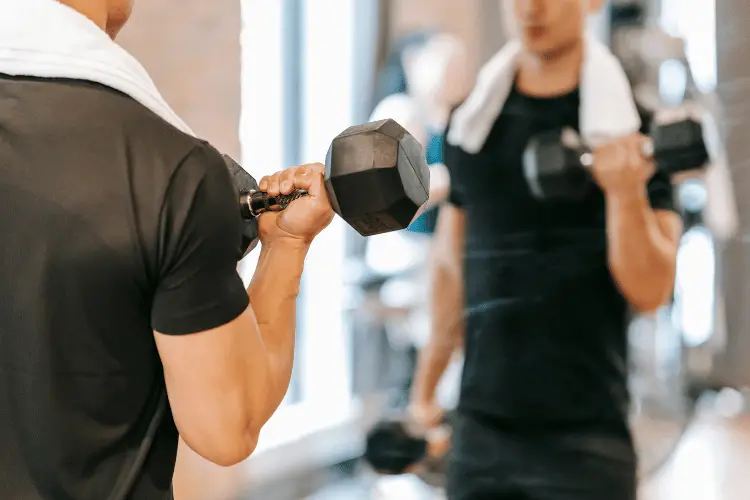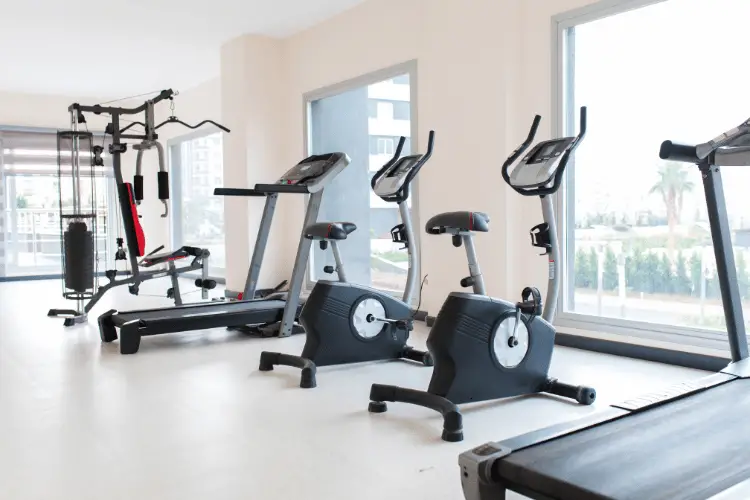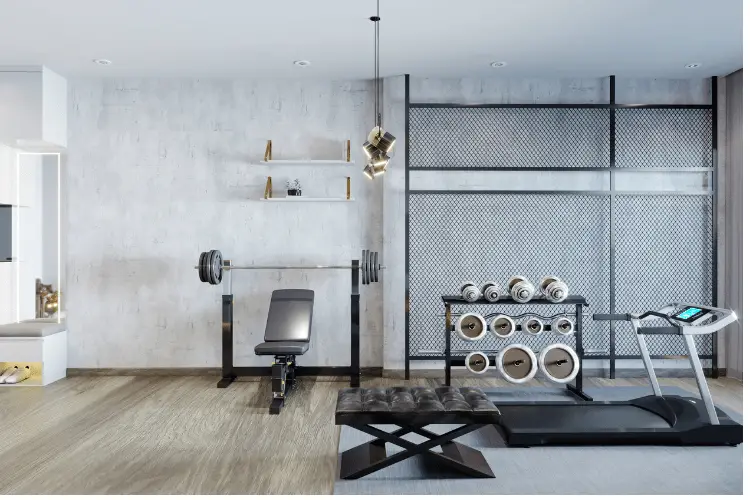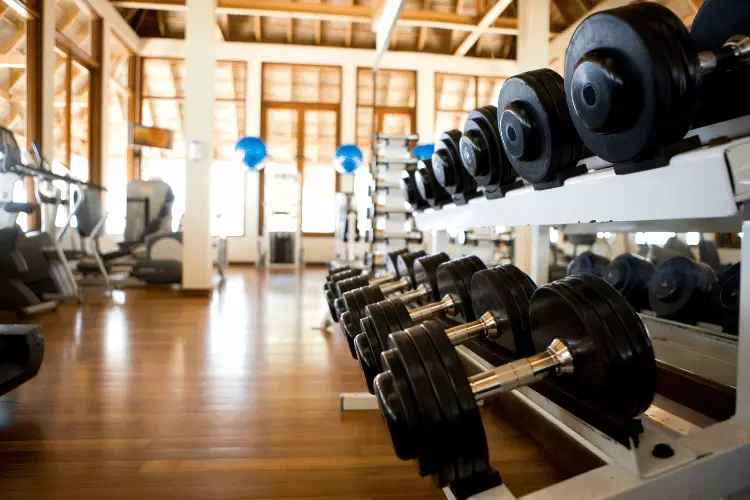So, you’ve decided to rent an apartment with an in-building gym. Now, you’re wondering if it’s going to be worth it.
Or maybe you’re a property manager, and you’ve been toying with the idea of adding a fitness center to your complex for a while. But that leap of faith is never easy, is it?
Either way, before you commit to either of the above ideas, I’ll walk you through all there is to know about apartment gyms, from the financial aspects to the optimal flooring choice.
Are Apartment Gyms Any Good?
Any facility has its pros and cons, but apartment gyms can generally add value to apartment complexes.
Before we dig into the details, let’s see if the financial benefits and convenient access make in-building fitness amenities worth the hassle.
Are Apartment Gyms Worth the Money?
Recently, more and more property owners have chosen to invest in apartment gyms. The main reason behind this rising trend is that in-building gyms can boost property value—if done right.
On the other side of the equation, renters will save whatever money they would have had to pay for membership throughout the year.
For instance, if the nearest commercial gym charges you $50 per month (an average estimate for the US), you’ll be saving $600 annually. Not including the savings on commutes.
Naturally, longer leases mean more savings in one go.
Gym Membership vs. Apartment Gym: Which Is Better?
There are a few factors that might sway some people towards ditching the membership and using the fitness center in their building.
1. Reduced Costs
Did you know that Americans spent around $34.8 billion on gym memberships in 2019? It’s true, and $1.3 billion of this estimate went to unused memberships!
One of the appeals of using an apartment gym is that you won’t have to spend money on a membership.
That’s not to say that your landlord is giving you access to fitness equipment out of the goodness in his heart. If your building has an apartment gym, odds are, your rent includes the fees. But you might as well make the most of it and waste what you’ve already paid for.
According to a survey by RentCafe, the gap between rent in regular buildings and those with fitness amenities depends on the area. For instance, the average rent in New York is $3,879, but you can expect to pay $4,280 for an apartment with gym access.
The gap isn’t always this large, though. Add $58 to your rent in Austin, and you’ll probably be able to afford a place in a building with a gym.
2. Time Saving
Some people like walking to their gyms; it helps them warm up a bit before exercising.
However, if you live in a car-dependent city, you’ll know that commuting back and forth can be a huge waste of time. That might be the reason why some people let their memberships go to waste.
In fact, a report by The Wall Street Journal found that people who live 3.7 miles away from their gyms are more likely to go to training sessions five or more times per week. Meanwhile, if this distance increases to 5.1 miles, most members will hit the gym only once a month.
Imagine if you cut this distance to zero—just a flight of stairs or a short elevator ride away from your home. Wouldn’t you work out more?
3. 24/7 Availability
It’s possible to find a commercial gym near you that’s open 24/7, but not everyone will be that lucky. On the other hand, residents usually have access to fitness centers inside the building all day and night—no weekend hours or holiday schedules to worry about.
Why is that such a perk?
Well, not all of us have conventional work hours that allow us to exercise directly after our 9–5 jobs. Some people need to squeeze in a quick workout after midnight (Don’t worry; that’s not always harmful to your sleep cycle.)
So, in cases like this, exercising in your building might be safer and more convenient than having to travel to the nearest 24/7 gym.
4. Limited Access
Many property managers choose to restrict gym access to residents only. That’s a double-edged sword, though.
It could be a perk because you’ll get a more private experience away from overcrowded gym facilities. Yet, you probably won’t be able to work out with friends, which can be a major drawback for some people. Sometimes people will only go to the gym with a friend.
Consider asking the manager for guest access if that’s a priority for you. He could allow it for a fee. Otherwise, you and your friends might need to get memberships at the nearest gym.
5. Customization Potential
You may be able to ask the owner to provide specific equipment that might be missing. That’s not always easy in regular health clubs, and it’s near impossible with the big chains.
On average, a commercial gym has around 1,500 members. Sure, a large-scale club might have feedback channels, but you can’t realistically expect your opinion to influence the management’s decision-making process all that much.
Now, consider how small-scale an apartment gym is. Even if you live in a mid-rise building, there will probably be around 160 units. This way, it’s going to be easier to get the owner to hear your suggestions and actually consider them.
What’s the Ideal Apartment Gym Design, Anyway?
Speaking of gym design and quality, a few key factors can make or break an apartment gym.
Let’s take a look at some of the aspects to keep in mind when designing an in-building fitness center:
Load Limits
Although it’s convenient, it’s not always possible to set up a gym on the first floor. But could even the second floor (or any level, for that matter) handle the weight loads of a full-on fitness center?
To answer this question, you have to consider the live load. Live load is basically the weight you can safely put on the floor, including furniture, appliances, decor, and even people!
Residential buildings tend to have a live load of 40 pounds per square foot. Meanwhile, it’s recommended to have a live load of 150 pounds per square foot for a full-on fitness center.
Don’t let the numbers shock you; the apartment gym setup is still doable, provided that all the loads are distributed along the floor. Owners have to keep building codes in mind before choosing the right spot for the gym.
Spacious Area
One of the main appeals of an apartment gym is that it’s not as crowded, so let’s keep it that way.
For starters, the area should be adjusted to the number of members that will use the facility at any given time. Ideally, there should be 36 square feet for each member.
Keep in mind that equipment will need its own square footage to prevent injuries.
You can check the manufacturer’s recommendations, but ACE’s guidelines can offer a general idea about what kind of space the different types of equipment will take up:
- Treadmills and ellipticals: 30 square feet (with 6–8 feet wall clearance for treadmills)
- Rowing machines and free weights: 20 square feet
No Full-Length Mirrors

Full-length mirrors are a major no-no.
The last thing anyone wants is a dumbbell falling to the floor, rolling all the way to the mirror, and shattering glass everywhere. Sure, gym-grade mirrors might be more resilient than the average home mirror, but they’ll still break after a serious hit.
I’ve seen this exact scenario happen in an apartment gym. It’s not a “Let’s hope it doesn’t happen” kind of thing. It is just a matter of time before it breaks.
In most cases, a 3×5-foot mirror elevated 16–22 inches off the floor will do the trick.
Safety Regulations
Just like their commercial counterparts, residential gyms need to follow general safety codes, including the following:
- Clearly labeled and easy-access emergency exits
- Fire protection systems and functioning alarms
- Adequate ventilation and air conditioning
- Regular air quality monitoring (dust, mold, etc.)
- Relative humidity between 40%–60%
Additionally, the superintendent needs to check for hazards, like torn carpets or unreliable electric outlets.
Amenities
Some extra amenities can make the apartment gym much more enticing to potential tenants.
For one, a strong Wi-Fi signal can be a major plus for those who want to stream music, listen to podcasts or watch workout videos during their workout sessions. Vending machines and water fountains are also two extra additions to consider.
Most importantly, the apartment complex owner has to pick the right spot for the bathroom.
Now, this design aspect can be a bit tricky. Ideally, you want the bathroom to be close enough so gym-goers can find it more convenient than going back to their apartments between workouts.
However, you also don’t want it inside the exercise area. I’ve been in apartment gyms where the bathroom is so close that the gym smells like a bathroom. Think this one all the way through.
In most cases, setting the bathroom on the same floor but in a separate section of the building works best. And you better get a great ventilation system.
How Do You Choose the Right Apartment Gym Flooring?
You can’t expect a fitness center to raise property value unless it looks at least like a semi-professional gym.
As it happens, flooring choices play a huge part here. They factor into aesthetics, comfort, safety, and even noise-level compliance.
Your Top Options
For the gym floor, the most common options are:
Some people go for interlocking tiles because they offer more flexibility in the layout. Plus, it’s possible to keep some tiles aside and use them as spares when parts of the floor wear out.
Keep in mind that thick rubber flooring works best for heavy machines and weight lifting. However, you don’t want the mat to be so thick that the gym-goers lose underfoot support. A ½-inch mat/tile will do the trick in most cases, provided that the material isn’t too compressible.
On the plus side, thick mats protect the subfloor and provide some soundproofing qualities. But we’ll get to all-things-noise in a minute!
The floor choice needs to be anti-slip, water-resistant, and easy to install. Of course, some tiles require adhesive, while others can go on the existing floor without glue. So, don’t forget to factor in how adjustable you need your layout to be in the long term.
Concrete Is Your No.1 Enemy
Although it might contribute to the aesthetic, a concrete floor isn’t the best pick for any gym.
Here’s why:
1. Concrete Can Be Hard to Maintain
Compared to foam and rubber, concrete is more prone to chipping and cracking, especially near a weight-lifting rack or where metal dumbbells get dropped. Those cracks won’t be easy to repair, and they’ll collect bacteria.
I have worked in a gym where we had stained and sealed concrete in specific areas. It added a nice aesthetic appeal, but it didn’t add any functionality to the gym.
2. Concrete Doesn’t Absorb Shock
Concrete can echo shocks throughout the gym-goers’ joints. This applies to all hard surfaces (hardwood, tiles, etc.), not just concrete.
Instead, you’ll want to use something with more shock-absorbing potential, like cushioned rubber.
3. It Is Easy to Slip on Concrete
It’s easier to slip on a concrete floor than on a textured rubber mat.
Guess what? People sweat in the gym. All it takes is a few drops to hit the floor and you’ve got a safety hazard.
Keep in mind that slips can be quite dangerous. For instance, one study found that falls and awkward landings account for 28.5% and 25.8% of gym-related injuries during group exercise sessions.
How Can You Pick the Best Apartment Gym Equipment?
After tackling the general design and flooring elements, it’s time to consider what equipment is enough for an apartment gym.
Since the residential fitness amenities function on a small scale, there is no need to go overboard and buy multiple versions of the same device. However, it’s still crucial to cover all muscle groups.
Residential vs. Commercial Gym Equipment
If you (or your landlord) go shopping for equipment to add to the apartment gym, you’ll have two main options: commercial-grade and residential-grade machines.
Your first instinct might be to pick residential-grade machines because it’s in the name, right? Well, let’s first talk about the differences.
Commercial-Grade
Commercial-grade exercise machines are built to last in the face of abuse. You’ll be able to see this quality reflected in the padding, ergonomics, and even paint finishes.
So, you won’t have to worry about replacing them too often if they’re only getting light usage in an apartment gym.
On the flip side, they can be expensive and a bit harder to install.
Residential-Grade
Residential-grade machines, on the other hand, are built for light to moderate use.
However, they’re budget-friendly and usually made to be versatile and save space. So, you’ll often find them in multi-functional models.
Finding the Right Balance
Ultimately, you can get either machine grade. It all depends on how much foot traffic you expect the gym to get. After all, you don’t want to cheapen out on residential-grade machines only to have to spend more on maintenance later.
You can opt for commercial-grade in popular machines like ellipticals, treadmills, or rowing machines. Then, balance things out with 1–2 multifunctional residential pieces. That could be a good compromise for an apartment gym.

Your Top Options
With all the differences between commercial-grade and residential-grade gym machines in mind, let’s take a look at some of the top options out there:
| Machine/Grade | Exercises | Machine Weight |
| Sportsroyals Power Tower (Residential) | Vertical knee raises, push-ups, pull-ups, and dips | 62.8 pounds |
| Marcy Smith Machine Cage System (Residential) | Squats, bench presses, one-arm curls, butterfly presses, landmine presses, pull-ups, lat push-downs, etc. | 300 pounds |
| RitFit Garage & Home Gym Package (Residential) | Squats, bench presses, deadlifts, pull-ups, landmines, chin-ups, and lat pull-downs | 25 pounds |
| Body-Solid Pro Clubline S1000 Four Stack (Commercial) | Leg presses, calf raises, ab crutches, standing leg curls, seated row, lat pull-downs, kickbacks, hip abductions, etc. (four people at the same time) | 1,728 Pounds |
| Concept2 Model D (Commercial) | Rows with PM5 performance monitor | 57 pounds |
| RitFit Medicine Balls (Non-specified) | HIIT workouts and squash workouts | 10, 15, and 20 pounds |
You’ll also need to throw a traditional free weight station or two and a quiet punching bag into the mix.
Nifty Features to Look For
If you don’t mind splurging a bit, you can look for machines with:
- Workout tracking features
- A wide range of resistances
- Gamified workout/VR compatibility
These features might be pricey, and you could get by without smart equipment.
However, they can make the residents feel like the apartment gym is on-par with the membership-based facilities on the street. So, I think they can be well worth the investment, especially if the building is in a high-rent area.
Can You Create an Apartment Balcony Gym?
Yes, it’s possible to convert a balcony in a residential building into a gym as long as you check the live load limits. The view alone might be a great motivator!
But there are two catches.
For one, you need to make sure there’s enough space on the balcony. The last thing you want is to be thrown back into the wall because the treadmill didn’t have enough clearance.
The second issue is that you wouldn’t want to invest in gym machines only to have them all rust out in under a year. Unfortunately, corrosion is more than likely if you live somewhere with a lot of rain or high humidity.
A third issue is that the apartment management may not like it.
Here are five simple tips to help you work out in your balcony gym without worrying about the elements:
1. Look for Weatherproof Equipment
In balcony gyms, you’ll be better off with outdoor equipment.
No, I’m not just talking about power towers. You can find outdoor equipment that targets cardio, strength, balance, or flexibility. After all, some brands, like Hags, already sell weatherproof equipment.
Make sure to confirm with the manufacturer that the tools will be used on a balcony and not a backyard for safety and installation compatibility reasons.
Alternatively, you can look for models with corrosion-resistant finishes, like Cerakote. Stainless steel could be a good fit, too, but it’ll need regular maintenance.
2. Keep the Setup Portable
If you only need equipment for light workouts, you can pick portable models. This way, you can bring the whole setup inside if the weather starts acting up.
In this case, multi-functional boards, Concept 2 rowing machines, foldable exercise bikes, and portable stair steppers will do the trick. On the plus side, these options will mostly be residential-grade, lightweight, and fairly inexpensive.
3. Add Some Protection Against the Elements
Whether you bought weather-resistant equipment or not, it’s always a good idea to go the extra mile with protective measures.
For instance, you can get machine covers to keep dust and moisture away.
You can even opt for a canopy over the balcony to protect the paint finishes and seats from UV rays. Remember that even if the metal parts don’t rust, the upholstery could crack with sunlight exposure!
While a dehumidifier is often a good idea for a basement gym, it might not be as effective in an open balcony.
4. Don’t Neglect the Maintenance Routine
Just like backyard gyms, balcony setups need some TLC to remain in tip-top shape. That’s why you need to keep up with the following maintenance chores:
- Dust the equipment and wash the mats regularly.
- Touch up the bars with oil every now and then.
- Consider using a silicone spray before heavy rainfall.
- Opt for galvanized steel bolts during repairs.
- Touch up the paint finish to cover up any chipping.
5. Consider Enclosing the Balcony
Setting up a gym on a balcony is going to be so much easier if you consider closing the area. This way, you won’t have to worry too much about the elements!
You don’t even need to wall it up; glass windows will do fine and won’t compromise the view.
However, the construction could be a bit expensive, especially since you’ll need to factor installing HVAC systems into the budget.
Can You Have a Home Gym in an Apartment?
Yes, it’s entirely possible to set up a home gym in your apartment.
That said, I’d still recommend double-checking with your local zoning office. You’ll want to know all the details before you start splurging on equipment.
Don’t worry; the paperwork won’t be as heavy as the one required for opening a commercial gym. But you might have to work around some regulations.
Plus, you’ll need to read the fine print in the lease and look for clauses that cover home gym setups. Otherwise, you might need to get approval from the property owner.
Yet, for the most part, I think noise control will be the main issue to tackle.

How Can You Control Apartment Gym Noise Levels?
Did you know that dropping a 45-pound kettlebell can create a noise level of a whopping 80 decibels? Over time, this can be rather harmful to gym-goers.
But that’s not all.
Lifting weights or jumping around is sure to annoy your downstairs neighbors, especially if you live in an old building with squeaky floors.
The best solution, in this case, is to use the ground floor for the gym. You can also place the facility next to other in-building amenities instead of residential units.
5 Tips for Apartment Gym Noise Control
Shifting the gym’s location won’t always be an option. Plus, it turns out that the noise could annoy the people living above the gym, too.
So, to keep noise complaints to a minimum, try the following tricks:
- Place thick rubber mats under the equipment to absorb some of the vibrations.
- Lubricate the equipment often to reduce squeaks.
- Install soundproofing foam (acoustic panels) on the walls, ceiling, and floor.
- Look into floating floors to minimize the noise from dropped weights.
- Consider soundproofing the apartments affected by the noise, too.
Apartment Gym Ideas
If you’re into the concept of apartment gyms but running low on ideas, you could check out these handy resources to get the creative juices flowing:
- Enclosed balcony gym by Merrick
- Glass separators for residential gyms
- Shelved door with concealed closet for gyms
- Focal wall ideas for apartment gyms
- Home gym with natural light
The Bottom Line
At its core, an apartment gym is a way for landlords to boost property value, all while offering a no-commute, no-membership fitness opportunity for the residents. That’s a win-win in my book!
References
- https://edition.cnn.com/2022/11/12/business/planet-fitness-gym-10-dollar-membership-ctrp/index.html
- https://www.finder.com/unused-gym-memberships
- https://www.rentcafe.com/blog/apartmentliving/lifestyle/apartment-buildings-with-gyms-fitness-amenities/
- https://www.esquire.com/lifestyle/health/news/a54143/missing-gym-workouts/
- https://www.exercise.com/learn/average-number-gym-members-to-be-successful/
- https://www.rentcafe.com/blog/apartmentliving/high-mid-rise-residential-buildings-overshadowing-low-rise/
- https://www.hunker.com/13400811/how-to-calculate-floor-load-capacity
- https://www.wbdg.org/space-types/physical-fitness-exercise-room
- https://www.exercise.com/learn/space-required-for-commercial-gym/
- https://www.acefitness.org/resources/everyone/blog/6625/home-gym-design-how-to-design-a-home-gym/
- https://livehealthy.chron.com/treadmill-safe-inside-house-4157.html
- https://www.hackensackmeridianhealth.org/en/HealthU/2020/09/25/what-floors-are-best-to-work-out-on
- https://www.ncbi.nlm.nih.gov/pmc/articles/PMC5005555/
- https://medium.com/@johngreavesiii/easy-ways-to-protect-outdoor-gym-equipment-961b72727e6c
- https://www.ihrsa.org/improve-your-club/bad-vibrations-why-you-need-to-protect-your-gym-from-excessive-noise/



